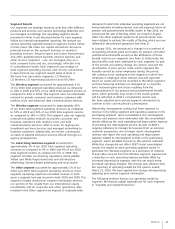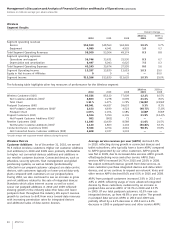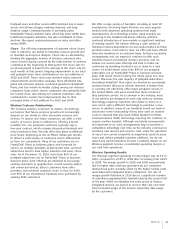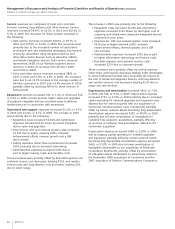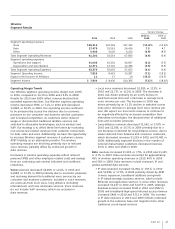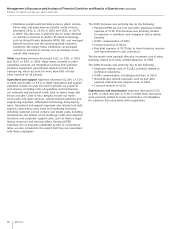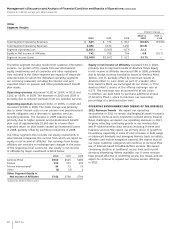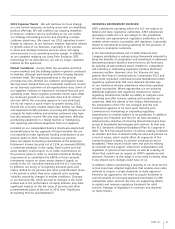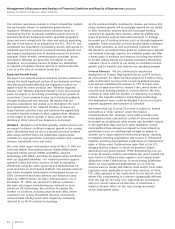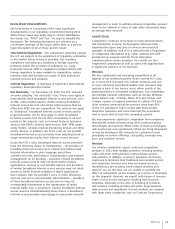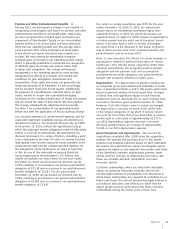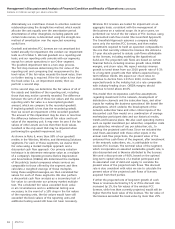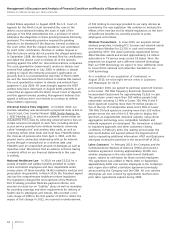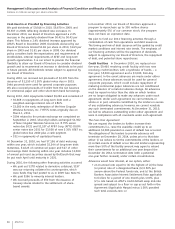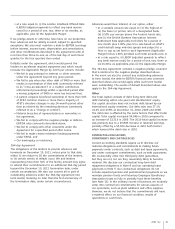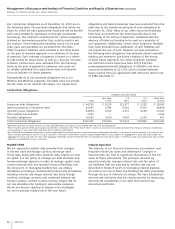AT&T Wireless 2010 Annual Report Download - page 45
Download and view the complete annual report
Please find page 45 of the 2010 AT&T Wireless annual report below. You can navigate through the pages in the report by either clicking on the pages listed below, or by using the keyword search tool below to find specific information within the annual report.
AT&T Inc. 43
management in order to address network congestion, prevent
harm to the network or users, or take other reasonable steps
to manage their network.
COMPETITION
Competition continues to increase for telecommunications
and information services. Technological advances have
expanded the types and uses of services and products
available. In addition, lack of or a reduced level of regulation
of comparable alternatives (e.g., cable, wireless and VoIP
providers) has lowered costs for these alternative
communications service providers. As a result, we face
heightened competition as well as some new opportunities
in significant portions of our business.
Wireless
We face substantial and increasing competition in all
aspects of our wireless business. Under current FCC rules,
six or more PCS licensees, two cellular licensees and one
or more enhanced specialized mobile radio licensees may
operate in each of our service areas, which results in the
potential presence of multiple competitors. Our competitors
are multiple national companies, such as Verizon Wireless,
Sprint Nextel Corp., T-Mobile, Metro PCS and Cricket, and
a larger number of regional providers of cellular, PCS and
other wireless communications services. More than 95%
of the U.S. population lives in areas with three mobile
telephone operators, and more than half the population
lives in areas with at least five competing carriers.
We may experience significant competition from companies
that provide similar services using other communications
technologies and services. While some of these technologies
and services are now operational, others are being developed
or may be developed. We compete for customers based
principally on service offerings, call quality, coverage area,
price and customer service.
Wireline
Our wireline subsidiaries expect continued competitive
pressure in 2011 from multiple providers, including wireless,
cable and other VoIP providers, interexchange carriers
and resellers. In addition, economic pressures are forcing
customers to terminate their traditional local wireline service
and substitute wireless and Internet-based services,
intensifying a pre-existing trend toward wireless and
Internet use. At this time, we are unable to quantify the
effect of competition on the industry as a whole or financially
on this segment. However, we expect both losses of revenue
share in local service and gains resulting from business
initiatives, especially in the area of bundling of products
and services, including wireless and video, large-business
data services and broadband. In most markets, we compete
with large cable companies, such as Comcast Corporation,
REGULATORY DEVELOPMENTS
Set forth below is a summary of the most significant
developments in our regulatory environment during 2010.
While these issues may apply only to certain subsidiaries,
the words “we,” “AT&T” and “our” are used to simplify the
discussion. The following discussions are intended as a
condensed summary of the issues rather than as a precise
legal description of all of these specific issues.
International Regulation Our subsidiaries operating outside
the U.S. are subject to the jurisdiction of regulatory authorities
in the market where service is provided. Our licensing,
compliance and advocacy initiatives in foreign countries
primarily enable the provision of enterprise (i.e., large-
business) services. AT&T is engaged in multiple efforts with
foreign regulators to open markets to competition, reduce
network costs and increase our scope of fully authorized
network services and products.
Federal Regulation A summary of significant 2010 federal
regulatory developments follows.
Net Neutrality On December 23, 2010, the FCC released
an order adopting “net neutrality” rules. These rules apply to
mass-market retail broadband Internet access services, such
as DSL, cable modem service, mobile wireless broadband
Internet access services and similar retail services that are
offered by AT&T and our competitors. The rules do not apply
to “enterprise” broadband Internet access services sold to
large businesses, nor do they apply to other broadband
IP-based services that do not offer connectivity to all end
points on the Internet, such as Internet Protocol television
services like AT&T’s U-verse video service; VoIP; VPN; smart
utility meters, wireless medical monitoring devices and other
similar devices. In addition, the FCC’s rules do not prohibit
broadband Internet access providers from adopting tiered or
usage-sensitive pricing for their Internet access services.
Under the FCC’s rules, broadband Internet access providers
have the following duties: (i) transparency – all providers of
broadband Internet access service (fixed and mobile) must
disclose information in plain language about their
commercial terms, performance characteristics, and network
management; (ii) no blocking – providers of fixed broadband
Internet access services may not block lawful content,
applications, services or non-harmful devices, and providers
of mobile broadband Internet access services may not block
access to lawful Internet websites or lawful applications
that compete with the provider’s voice or video telephony
services; and (iii) no unreasonable discrimination – providers
of fixed broadband Internet access service may not
unreasonably discriminate in the transmission of lawful
Internet traffic over a consumer’s wireline broadband Internet
access services. Notwithstanding these duties, a broadband
Internet access provider may engage in reasonable network


